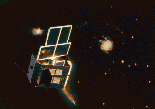|
|
EXOSAT Low Energy experiment (LE+CMA)
A schematic view of the LE detector

Data products
The available data products for the two Low Energy telescopes
(LE: LE1 and LE2) used in combination with the Channel Multipler
Array (CMA: CMA1 and CMA2) detectors are images and lightcurves.
There are no products for the LE telescopes used in combination with
the Position Sensitive proportional counter Detectors (PSD) due to the
failure of both detectors during the performance verification phase.
The LE+CMA image and lightcurve products were originally created,
in binary format, at the EXOSAT observatory during the post operational phase.
HEASARC converted all the products in FITS format. These files are available from
EXOSAT cma1 and cma2
FTP area in the HEASARC archives.
- Images :
During a typical EXOSAT observation the LE+CMA's were used in
conjunction with broad band filters. For both telescopes, images
were accumulated for each filter in use during an observation, and
stored in a binary format. The EXOSAT FITS images, stored in the
FITS primary array, consist of a header followed by the
2048 X 2048 pixel image. The images are in linearized
detector coordinates. The projection is `tangent plane' and the images
do not have the y-axis direction aligned with celestial north.
In pixels the coordinate system runs from -1024 to 1023 in X and Y,
all the calibrations and documents uses the above pixel convention.
The total number of EXOSAT images available are 3366 for the LE1+CMA1
and 405 for the LE2+CMA2. The difference in number between the two
telescopes is due to a failure of the CMA2 detector early in the
mission lifetime.
HEASARC generated also GIF images (available from the
EXOSAT cma1 and cma2 FTP area) for each FITS image file.
The GIF images contain two different views (left and right)
of the EXOSAT field with an appropriate color lookup table and scaling.
The left view shows the complete FOV (2 X 2 degrees), while
the right view zooms in on the central one degree region.
A CDROM (vol1)
containing all the images in FITS and GIF format is available
and was first distributed at the 186th AAS Meeting
(11-15 June 1995 Pittsburgh Pennsylvania).
- Lightcurves :
Lightcurves, in binary format, were obtained for each detected source
in the 2 X 2 deg FOV of the CMA images. The lightcurves are background
subtracted and dead time corrected. Associated to each image, there are
also background lightcurves, obtained using part of CMA field
of view after removing detected sources. HEASARC converted all
EXOSAT LE+CMA lightcurves in FITS format using the FITS binary table
extension (BINTABLE). The specific layout of the data is described in the
Legacy Journal 3, 32. The total number of EXOSAT lightcurve are 10124
for the CMA1 and 1817 for the CMA2.
HEASARC generated also GIF files (available from the
EXOSAT cma1 and cma2 FTP area) for each FITS lightcurve.
A CDROM (vol2)
containing all the lightcurves in FITS and GIF format is available
and was first distributed at the 188th AAS Meeting
(9-13 June 1996 Madison, Wisconsin).
Products naming convention
The LE+CMA product file names are a 6-character strings, a letter followed by
a 5-digit number, generated automatically by the computer, based on the start
time of the observation. The first character, which identifies the
product type, has a different convention for the 3 experiments (LE+CMA,
ME and GS), but within an experiment different products associated
with the same observation share the 5 digit number. The LE+CMA images
have `a' as the first character, `b' is used for the LE+CMA background
lightcurve, and from `c' on, alphabetically, are the lightcurves for
the different sources detected in the Field of View.
Software
- Products:
The FITS images may be displayed using any standard package which
accepts FITS images. SAOIMAGE for UNIX and VMS, NIHImage for MacOS,
IMDISP under DOS and FITSview under MS Windows.
XIMAGE (on UNIX and VMS) and IDL are also useful for display and
analysis of the FITS image file. The GIF images can be viewed on
UNIX and VMS with the package xv, under DOS with ColorView and
under MacOS with Giffer.
XRONOS
is useful for analysis of the FITS lightcurves. The
FTOOLS package provides also a number of programs to manipulate
the FITS file.
[EXOSAT Home]
[About EXOSAT]
[Archive]
[Software]
[Gallery]
[Publications]
Page authors: Lorella Angelini Jesse Allen
HEASARC Home |
Observatories |
Archive |
Calibration |
Software |
Tools |
Students/Teachers/Public
Last modified: Tuesday, 21-Apr-2020 17:00:50 EDT
|


